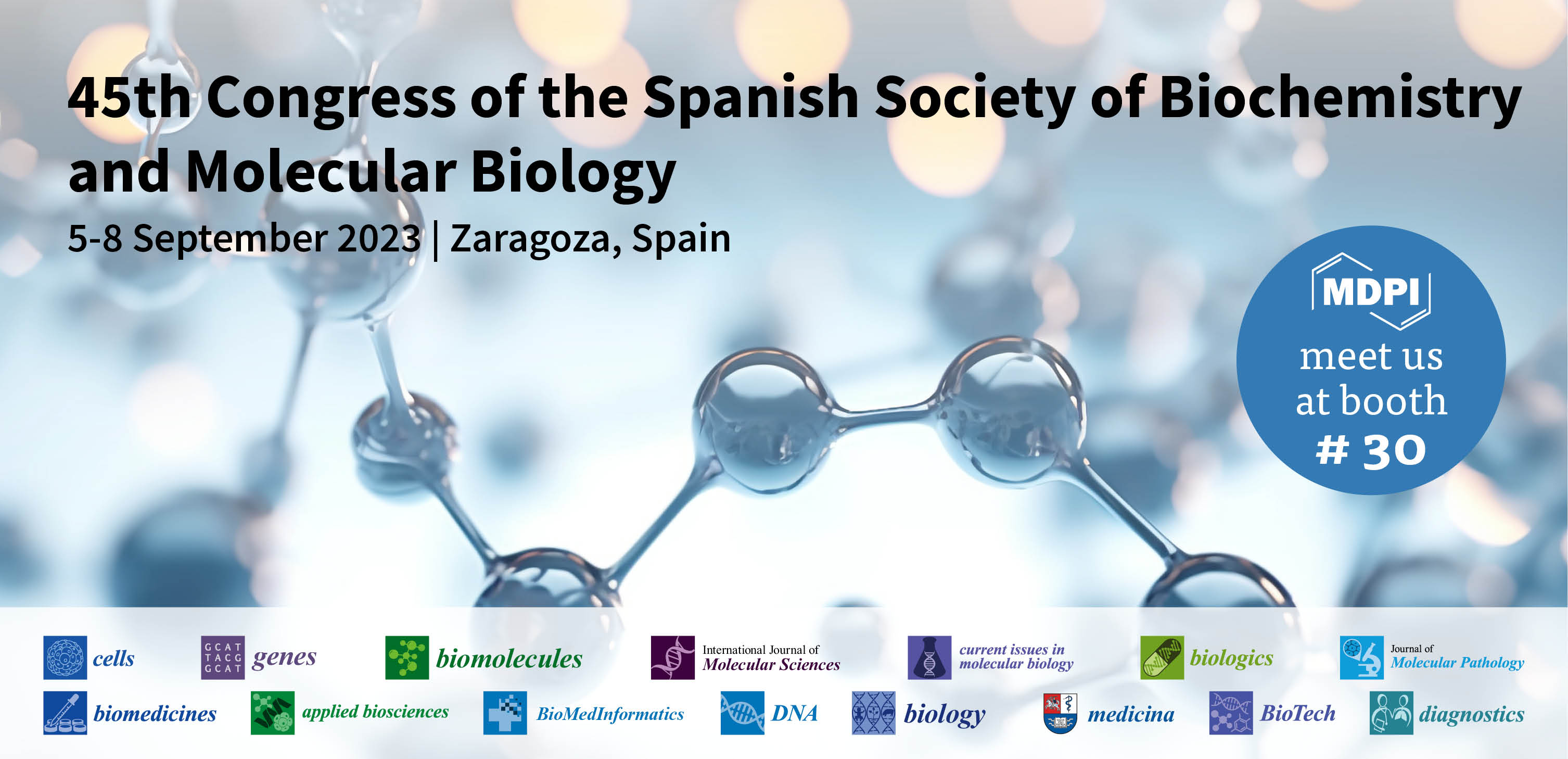Journal Description
Cells
Cells
is an international, peer-reviewed, open access journal of cell biology, molecular biology, and biophysics, published semimonthly online by MDPI. The Spanish Society for Biochemistry and Molecular Biology (SEBBM), Nordic Autophagy Society (NAS), Spanish Society of Hematology and Hemotherapy (SEHH) and Society for Regenerative Medicine (Russian Federation) (RPO) are affiliated with Cells and their members receive discounts on the article processing charges.
- Open Access— free for readers, with article processing charges (APC) paid by authors or their institutions.
- High Visibility: indexed within Scopus, SCIE (Web of Science), PubMed, MEDLINE, PMC, CAPlus / SciFinder, and other databases.
- Journal Rank: JCR - Q2 (Cell Biology) / CiteScore - Q1 (General Biochemistry, Genetics and Molecular Biology)
- Rapid Publication: manuscripts are peer-reviewed and a first decision is provided to authors approximately 18.8 days after submission; acceptance to publication is undertaken in 2.9 days (median values for papers published in this journal in the first half of 2023).
- Recognition of Reviewers: reviewers who provide timely, thorough peer-review reports receive vouchers entitling them to a discount on the APC of their next publication in any MDPI journal, in appreciation of the work done.
- Sections: published in 22 topical sections.
- Companion journal: Organoids.
Impact Factor:
6.0 (2022);
5-Year Impact Factor:
6.7 (2022)
Latest Articles
Adenosinergic System and Neuroendocrine Syncope: What Is the Link?
Cells 2023, 12(16), 2027; https://doi.org/10.3390/cells12162027 - 08 Aug 2023
Abstract
Although very common, the precise mechanisms that explain the symptomatology of neuroendocrine syncope (NES) remain poorly understood. This disease, which can be very incapacitating, manifests itself as a drop in blood pressure secondary to vasodilation and/or extreme slowing of heart rate. As studies
[...] Read more.
Although very common, the precise mechanisms that explain the symptomatology of neuroendocrine syncope (NES) remain poorly understood. This disease, which can be very incapacitating, manifests itself as a drop in blood pressure secondary to vasodilation and/or extreme slowing of heart rate. As studies continue, the involvement of the adenosinergic system is becoming increasingly evident. Adenosine, which is an ATP derivative, may be involved in a large number of cases. Adenosine acts on G protein-coupled receptors with seven transmembrane domains. A1 and A2A adenosine receptor dysfunction seem to be particularly implicated since the activation leads to severe bradycardia or vasodilation, respectively, two cardinal symptoms of NES. This mini-review aims to shed light on the links between dysfunction of the adenosinergic system and NHS. In particular, signal transduction pathways through the modulation of cAMP production and ion channels in relation to effects on the cardiovascular system are addressed. A better understanding of these mechanisms could guide the pharmacological development of new therapeutic approaches.
Full article
(This article belongs to the Special Issue Adenosine and Adenosine Receptors in Human Disease)
►
Show Figures
Open AccessFeature PaperArticle
Effect of Vitamin D3 on Chemerin and Adiponectin Levels in Uterus of Polycystic Ovary Syndrome Rats
by
, , , , , , , and
Cells 2023, 12(16), 2026; https://doi.org/10.3390/cells12162026 - 08 Aug 2023
Abstract
Background: Polycystic ovary syndrome (PCOS) is an endocrine disorder with disrupted uterus structure and function. A positive effect of vitamin D3 (VD3) in female reproduction was observed. Chemerin (RARRES2) and adiponectin (ADIPOQ) are the main adipokines whose levels are altered
[...] Read more.
Background: Polycystic ovary syndrome (PCOS) is an endocrine disorder with disrupted uterus structure and function. A positive effect of vitamin D3 (VD3) in female reproduction was observed. Chemerin (RARRES2) and adiponectin (ADIPOQ) are the main adipokines whose levels are altered in PCOS patients. Therefore, the aim of this study was to investigate the impact of VD3 supplementation on RARRES2 and ADIPOQ levels in the uterus of PCOS rats. Methods: We analyzed the plasma levels and uterine transcript and protein expression of RARRES2 and ADIPOQ and their receptors (CCRL2, CMKLR1, GPR1, and ADIPOR1 and ADIPOR2, respectively) in rats with letrozole-induced PCOS. Results: In control animals, VD3 did not change plasma levels of both adipokines, while in PCOS rats supplemented with VD3, they returned to control levels. The expression of RARRES2 and all investigated receptors increased in the uterus of VD3-treated rats; however, the levels of Rarres2 and Gpr1 genes remained unchanged. VD3 supplementation decreased RARRES2, CMKLR1, and GPR1 but increased CCRL2 level to the control value. In the uterus of VD3-treated rats, the transcript and protein levels of ADIPOQ and both receptors ADIPOR1 increased. At the same time, VD3 supplementation induced an increase in Adipoq, Adipor1, and Adipor2 gene expression and restored protein levels to control level values. Conclusions: our findings indicate a new mechanism of VD3 action in the uterine physiology of PCOS rats.
Full article
(This article belongs to the Special Issue Adipose Tissue and Metabolic Disease)
Open AccessArticle
In Vitro Study of a Novel Vibrio alginolyticus-Based Collagenase for Future Medical Application
by
, , , , , , , , , , , and
Cells 2023, 12(16), 2025; https://doi.org/10.3390/cells12162025 - 08 Aug 2023
Abstract
►▼
Show Figures
Mesenchymal stem cells extracted from adipose tissue are particularly promising given the ease of harvest by standard liposuction and reduced donor site morbidity. This study proposes a novel enzymatic method for isolating stem cells using Vibrio alginolyticus collagenase, obtaining a high-quality product in
[...] Read more.
Mesenchymal stem cells extracted from adipose tissue are particularly promising given the ease of harvest by standard liposuction and reduced donor site morbidity. This study proposes a novel enzymatic method for isolating stem cells using Vibrio alginolyticus collagenase, obtaining a high-quality product in a reduced time. Initially, the enzyme concentration and incubation time were studied by comparing cellular yield, proliferation, and clonogenic capacities. The optimized protocol was phenotypically characterized, and its ability to differentiate in the mesodermal lineages was evaluated. Subsequently, that protocol was compared with two Clostridium histolyticum-based collagenases, and other tests for cellular integrity were performed to evaluate the enzyme’s effect on expanded cells. The best results showed that using a concentration of 3.6 mg/mL Vibrio alginolyticus collagenase allows extracting stem cells from adipose tissue after 20 min of enzymatic reaction like those obtained with Clostridium histolyticum-based collagenases after 45 min. Moreover, the extracted cells with Vibrio alginolyticus collagenase presented the phenotypic characteristics of stem cells that remain after culture conditions. Finally, it was seen that Vibrio alginolyticus collagenase does not reduce the vitality of expanded cells as Clostridium histolyticum-based collagenase does. These findings suggest that Vibrio alginolyticus collagenase has great potential in regenerative medicine, given its degradation selectivity by protecting vital structures for tissue restructuration.
Full article

Figure 1
Open AccessArticle
Neuronal atg1 Coordinates Autophagy Induction and Physiological Adaptations to Balance mTORC1 Signalling
Cells 2023, 12(16), 2024; https://doi.org/10.3390/cells12162024 - 08 Aug 2023
Abstract
The mTORC1 nutrient-sensing pathway integrates metabolic and endocrine signals into the brain to evoke physiological responses to food deprivation, such as autophagy. Nevertheless, the impact of neuronal mTORC1 activity on neuronal circuits and organismal metabolism remains obscure. Here, we show that mTORC1 inhibition
[...] Read more.
The mTORC1 nutrient-sensing pathway integrates metabolic and endocrine signals into the brain to evoke physiological responses to food deprivation, such as autophagy. Nevertheless, the impact of neuronal mTORC1 activity on neuronal circuits and organismal metabolism remains obscure. Here, we show that mTORC1 inhibition acutely perturbs serotonergic neurotransmission via proteostatic alterations evoked by the autophagy inducer atg1. Neuronal ATG1 alters the intracellular localization of the serotonin transporter, which increases the extracellular serotonin and stimulates the 5HTR7 postsynaptic receptor. 5HTR7 enhances food-searching behaviour and ecdysone-induced catabolism in Drosophila. Along similar lines, the pharmacological inhibition of mTORC1 in zebrafish also stimulates food-searching behaviour via serotonergic activity. These effects occur in parallel with neuronal autophagy induction, irrespective of the autophagic activity and the protein synthesis reduction. In addition, ectopic neuronal atg1 expression enhances catabolism via insulin pathway downregulation, impedes peptidergic secretion, and activates non-cell autonomous cAMP/PKA. The above exert diverse systemic effects on organismal metabolism, development, melanisation, and longevity. We conclude that neuronal atg1 aligns neuronal autophagy induction with distinct physiological modulations, to orchestrate a coordinated physiological response against reduced mTORC1 activity.
Full article
(This article belongs to the Special Issue Molecular Mechanisms and Biological Roles of Alternative Autophagy)
►▼
Show Figures
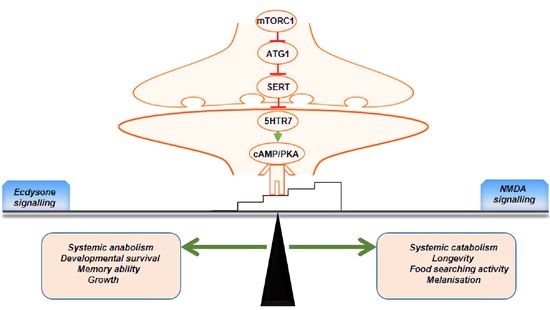
Graphical abstract
Open AccessArticle
MPP8 Governs the Activity of the LIF/STAT3 Pathway and Plays a Crucial Role in the Differentiation of Mouse Embryonic Stem Cells
Cells 2023, 12(16), 2023; https://doi.org/10.3390/cells12162023 - 08 Aug 2023
Abstract
Mouse embryonic stem cells (mESCs) possess the remarkable characteristics of unlimited self-renewal and pluripotency, which render them highly valuable for both fundamental research and clinical applications. A comprehensive understanding of the molecular mechanisms underlying mESC function is of the utmost importance. The Human
[...] Read more.
Mouse embryonic stem cells (mESCs) possess the remarkable characteristics of unlimited self-renewal and pluripotency, which render them highly valuable for both fundamental research and clinical applications. A comprehensive understanding of the molecular mechanisms underlying mESC function is of the utmost importance. The Human Silence Hub (HUSH) complex, comprising FAM208A, MPP8, and periphilin, constitutes an epigenetic silencing complex involved in suppressing retroviruses and transposons during early embryonic development. However, its precise role in regulating mESC pluripotency and differentiation remains elusive. In this study, we generated homogenous miniIAA7-tagged Mpp8 mouse ES cell lines. Upon induction of MPP8 protein degradation, we observed the impaired proliferation and reduced colony formation ability of mESCs. Furthermore, this study unveils the involvement of MPP8 in regulating the activity of the LIF/STAT3 signaling pathway and Nanog expression in mESCs. Finally, we provide compelling evidence that degradation of the MPP8 protein impairs the differentiation of mESC.
Full article
(This article belongs to the Topic Pluripotent Stem Cells)
►▼
Show Figures
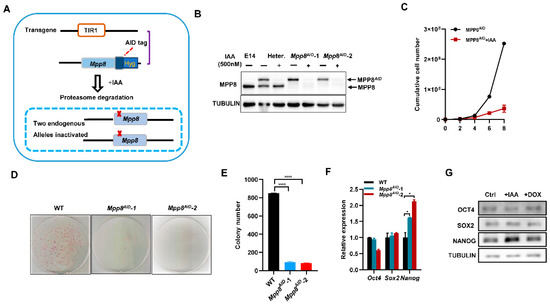
Figure 1
Open AccessArticle
Human Blood Serum Can Diminish EGFR-Targeted Inhibition of Squamous Carcinoma Cell Growth through Reactivation of MAPK and EGFR Pathways
by
, , , , , , , , , , and
Cells 2023, 12(16), 2022; https://doi.org/10.3390/cells12162022 - 08 Aug 2023
Abstract
Regardless of the presence or absence of specific diagnostic mutations, many cancer patients fail to respond to EGFR-targeted therapeutics, and a personalized approach is needed to identify putative (non)responders. We found previously that human peripheral blood and EGF can modulate the activities of
[...] Read more.
Regardless of the presence or absence of specific diagnostic mutations, many cancer patients fail to respond to EGFR-targeted therapeutics, and a personalized approach is needed to identify putative (non)responders. We found previously that human peripheral blood and EGF can modulate the activities of EGFR-specific drugs on inhibiting clonogenity in model EGFR-positive A431 squamous carcinoma cells. Here, we report that human serum can dramatically abolish the cell growth rate inhibition by EGFR-specific drugs cetuximab and erlotinib. We show that this phenomenon is linked with derepression of drug-induced G1S cell cycle transition arrest. Furthermore, A431 cell growth inhibition by cetuximab, erlotinib, and EGF correlates with a decreased activity of ERK1/2 proteins. In turn, the EGF- and human serum-mediated rescue of drug-treated A431 cells restores ERK1/2 activity in functional tests. RNA sequencing revealed 1271 and 1566 differentially expressed genes (DEGs) in the presence of cetuximab and erlotinib, respectively. Erlotinib- and cetuximab-specific DEGs significantly overlapped. Interestingly, the expression of 100% and 75% of these DEGs restores to the no-drug level when EGF or a mixed human serum sample, respectively, is added along with cetuximab. In the case of erlotinib, EGF and human serum restore the expression of 39% and 83% of DEGs, respectively. We further assessed differential molecular pathway activation levels and propose that EGF/human serum-mediated A431 resistance to EGFR drugs can be largely explained by reactivation of the MAPK signaling cascade.
Full article
(This article belongs to the Topic Advances in Anti-Cancer Drugs)
►▼
Show Figures
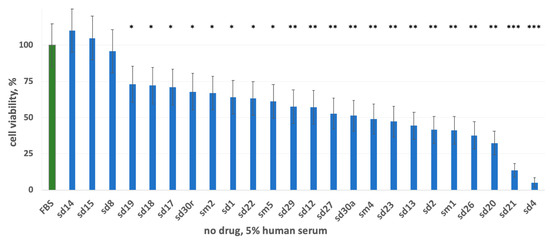
Figure 1
Open AccessReview
Hiding in Plain Sight: Human Gingival Fibroblasts as an Essential, Yet Overlooked, Tool in Regenerative Medicine
by
and
Cells 2023, 12(16), 2021; https://doi.org/10.3390/cells12162021 - 08 Aug 2023
Abstract
Adult human gingival fibroblasts (HGFs), the most abundant cells in the oral cavity, are essential for maintaining oral homeostasis. Compared with other tissues, adult oral mucosal wounds heal regeneratively, without scarring. Relative to fibroblasts from other locations, HGFs are relatively refractory to myofibroblast
[...] Read more.
Adult human gingival fibroblasts (HGFs), the most abundant cells in the oral cavity, are essential for maintaining oral homeostasis. Compared with other tissues, adult oral mucosal wounds heal regeneratively, without scarring. Relative to fibroblasts from other locations, HGFs are relatively refractory to myofibroblast differentiation, immunomodulatory, highly regenerative, readily obtained via minimally invasive procedures, easily and rapidly expanded in vitro, and highly responsive to growth factors and cytokines. Consequently, HGFs might be a superior, yet perhaps underappreciated, source of adult mesenchymal progenitor cells to use in tissue engineering and regeneration applications, including the treatment of fibrotic auto-immune connective tissue diseases such as scleroderma. Herein, we highlight in vitro and translational studies that have investigated the regenerative and differentiation potential of HGFs, with the objective of outlining current limitations and inspiring future research that could facilitate translating the regenerative potential of HGFs into the clinic.
Full article
(This article belongs to the Special Issue The Role of Epithelial Cells in Scleroderma)
►▼
Show Figures
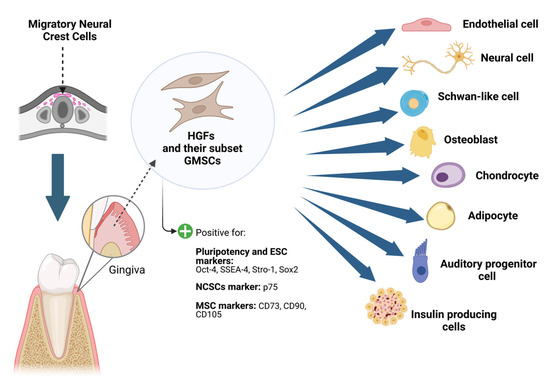
Figure 1
Open AccessReview
Common Marmoset Cell Lines and Their Applications in Biomedical Research
by
, , , , , and
Cells 2023, 12(16), 2020; https://doi.org/10.3390/cells12162020 - 08 Aug 2023
Abstract
Common marmosets (Callithrix jacchus; CMs) are small New World primates widely used in biomedical research. Early stages of such research often include in vitro experiments which require standardized and well-characterized CM cell cultures derived from different tissues. Despite the long history
[...] Read more.
Common marmosets (Callithrix jacchus; CMs) are small New World primates widely used in biomedical research. Early stages of such research often include in vitro experiments which require standardized and well-characterized CM cell cultures derived from different tissues. Despite the long history of laboratory work with CMs and high translational potential of such studies, the number of available standardized, well-defined, stable, and validated CM cell lines is still small. While primary cells and immortalized cell lines are mostly used for the studies of infectious diseases, biochemical research, and targeted gene therapy, the main current applications of CM embryonic stem cells and induced pluripotent stem cells are regenerative medicine, stem cell research, generation of transgenic CMs, transplantology, cell therapy, reproductive physiology, oncology, and neurodegenerative diseases. In this review we summarize the data on the main advantages, drawbacks and research applications of CM cell lines published to date including primary cells, immortalized cell lines, lymphoblastoid cell lines, embryonic stem cells, and induced pluripotent stem cells.
Full article
(This article belongs to the Topic Animal Models of Human Disease)
►▼
Show Figures
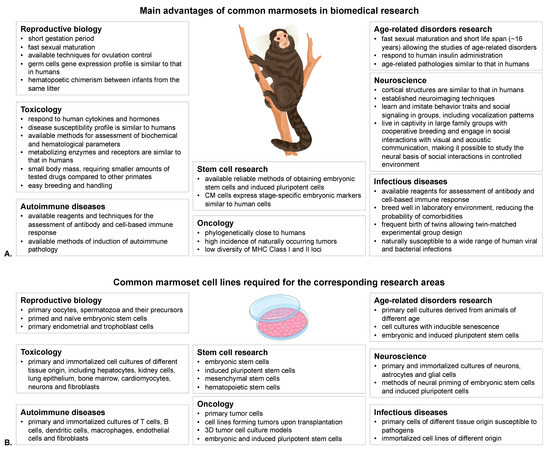
Figure 1
Open AccessReview
Hypometabolism, Alzheimer’s Disease, and Possible Therapeutic Targets: An Overview
by
, , , , and
Cells 2023, 12(16), 2019; https://doi.org/10.3390/cells12162019 - 08 Aug 2023
Abstract
The brain is a highly dynamic organ that requires a constant energy source to function normally. This energy is mostly supplied by glucose, a simple sugar that serves as the brain’s principal fuel source. Glucose transport across the blood–brain barrier (BBB) is primarily
[...] Read more.
The brain is a highly dynamic organ that requires a constant energy source to function normally. This energy is mostly supplied by glucose, a simple sugar that serves as the brain’s principal fuel source. Glucose transport across the blood–brain barrier (BBB) is primarily controlled via sodium-independent facilitated glucose transport, such as by glucose transporter 1 (GLUT1) and 3 (GLUT3). However, other glucose transporters, including GLUT4 and the sodium-dependent transporters SGLT1 and SGLT6, have been reported in vitro and in vivo. When the BBB endothelial layer is crossed, neurons and astrocytes can absorb the glucose using their GLUT1 and GLUT3 transporters. Glucose then enters the glycolytic pathway and is metabolized into adenosine triphosphate (ATP), which supplies the energy to support cellular functions. The transport and metabolism of glucose in the brain are impacted by several medical conditions, which can cause neurological and neuropsychiatric symptoms. Alzheimer’s disease (AD), Parkinson’s disease (PD), epilepsy, traumatic brain injury (TBI), schizophrenia, etc., are a few of the most prevalent disorders, characterized by a decline in brain metabolism or hypometabolism early in the course of the disease. Indeed, AD is considered a metabolic disorder related to decreased brain glucose metabolism, involving brain insulin resistance and age-dependent mitochondrial dysfunction. Although the conventional view is that reduced cerebral metabolism is an effect of neuronal loss and consequent brain atrophy, a growing body of evidence points to the opposite, where hypometabolism is prodromal or at least precedes the onset of brain atrophy and the manifestation of clinical symptoms. The underlying processes responsible for these glucose transport and metabolic abnormalities are complicated and remain poorly understood. This review article provides a comprehensive overview of the current understanding of hypometabolism in AD and potential therapeutic targets.
Full article
(This article belongs to the Special Issue Therapeutic Mechanism of Nervous System Inflammation)
►▼
Show Figures

Figure 1
Open AccessArticle
Biotechnological Potential of the Stress Response and Plant Cell Death Regulators Proteins in the Biofuel Industry
by
, , , , , , , , , , , , , , and
Cells 2023, 12(16), 2018; https://doi.org/10.3390/cells12162018 - 08 Aug 2023
Abstract
Production of biofuel from lignocellulosic biomass is relatively low due to the limited knowledge about natural cell wall loosening and cellulolytic processes in plants. Industrial separation of cellulose fiber mass from lignin, its saccharification and alcoholic fermentation is still cost-ineffective and environmentally unfriendly.
[...] Read more.
Production of biofuel from lignocellulosic biomass is relatively low due to the limited knowledge about natural cell wall loosening and cellulolytic processes in plants. Industrial separation of cellulose fiber mass from lignin, its saccharification and alcoholic fermentation is still cost-ineffective and environmentally unfriendly. Assuming that the green transformation is inevitable and that new sources of raw materials for biofuels are needed, we decided to study cell death—a natural process occurring in plants in the context of reducing the recalcitrance of lignocellulose for the production of second-generation bioethanol. “Members of the enzyme families responsible for lysigenous aerenchyma formation were identified during the root hypoxia stress in Arabidopsis thaliana cell death mutants. The cell death regulatory genes, LESION SIMULATING DISEASE 1 (LSD1), PHYTOALEXIN DEFICIENT 4 (PAD4) and ENHANCED DISEASE SUSCEPTIBILITY 1 (EDS1) conditionally regulate the cell wall when suppressed in transgenic aspen. During four years of growth in the field, the following effects were observed: lignin content was reduced, the cellulose fiber polymerization degree increased and the growth itself was unaffected. The wood of transgenic trees was more efficient as a substrate for saccharification, alcoholic fermentation and bioethanol production. The presented results may trigger the development of novel biotechnologies in the biofuel industry.
Full article
(This article belongs to the Special Issue Plant Genetics, Genomics, and Evolutionary in Context of Stress Responses)
►▼
Show Figures
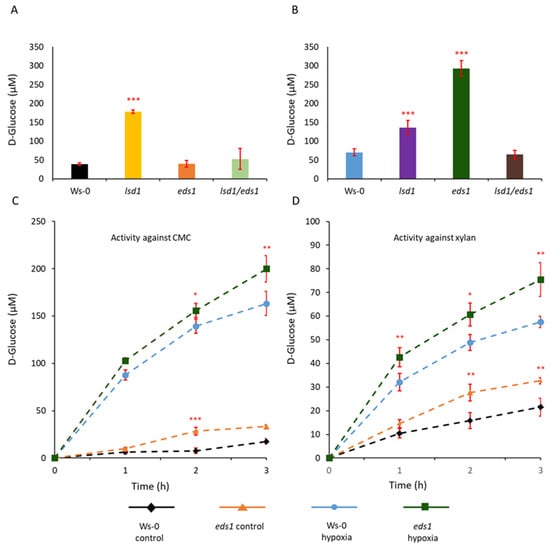
Figure 1
Open AccessArticle
The Role of Swelling in the Regulation of OPA1-Mediated Mitochondrial Function in the Heart In Vitro
by
, , , , and
Cells 2023, 12(16), 2017; https://doi.org/10.3390/cells12162017 - 08 Aug 2023
Abstract
Optic atrophy-1 (OPA1) plays a crucial role in the regulation of mitochondria fusion and participates in maintaining the structural integrity of mitochondrial cristae. Here we elucidate the role of OPA1 cleavage induced by calcium swelling in the presence of Myls22 (an OPA1 GTPase
[...] Read more.
Optic atrophy-1 (OPA1) plays a crucial role in the regulation of mitochondria fusion and participates in maintaining the structural integrity of mitochondrial cristae. Here we elucidate the role of OPA1 cleavage induced by calcium swelling in the presence of Myls22 (an OPA1 GTPase activity inhibitor) and TPEN (an OMA1 inhibitor). The rate of ADP-stimulated respiration was found diminished by both inhibitors, and they did not prevent Ca2+-induced mitochondrial respiratory dysfunction, membrane depolarization, or swelling. L-OPA1 cleavage was stimulated at state 3 respiration; therefore, our data suggest that L-OPA1 cleavage produces S-OPA1 to maintain mitochondrial bioenergetics in response to stress.
Full article
(This article belongs to the Special Issue Mitochondria at the Crossroad of Health and Disease)
►▼
Show Figures
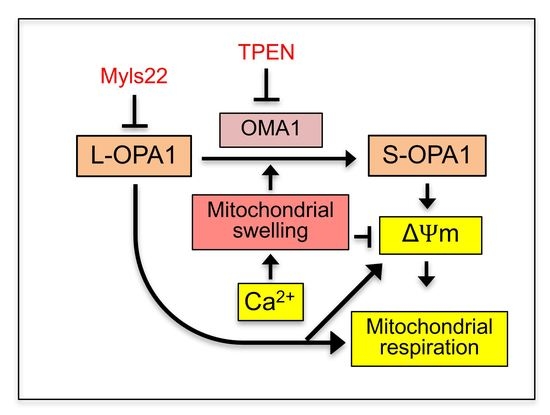
Graphical abstract
Open AccessReview
What’s in a Name? An Overview of the Proliferating Nomenclature in the Field of Phage Lysins
by
and
Cells 2023, 12(15), 2016; https://doi.org/10.3390/cells12152016 - 07 Aug 2023
Abstract
In the last few years, the volume of research produced on phage lysins has grown spectacularly due to the interest in using them as alternative antimicrobials. As a result, a plethora of naming customs has sprouted among the different research groups devoted to
[...] Read more.
In the last few years, the volume of research produced on phage lysins has grown spectacularly due to the interest in using them as alternative antimicrobials. As a result, a plethora of naming customs has sprouted among the different research groups devoted to them. While the naming diversity accounts for the vitality of the topic, on too many occasions it also creates some confusion and lack of comparability between different works. This article aims at clarifying the ambiguities found among names referring to phage lysins. We do so by tackling the naming customs historically, framing their original adoption, and employing a semantic classification to facilitate their discussion. We propose a periodization of phage lysin research that begins at the discovery era, in the early 20th century, enriches with a strong molecular biology period, and grows into a current time of markedly applied research. During these different periods, names referring to the general concepts surrounding lysins have been created and adopted, as well as other more specific terms related to their structure and function or, finally, names that have been coined for the antimicrobial application and engineering of phage lysins. Thus, this article means to serve as an invitation to the global lysin community to take action and discuss a widely supported, standardized nomenclature.
Full article
(This article belongs to the Special Issue Bacteriophages and Their Enzymes as Antibacterial Agents)
►▼
Show Figures
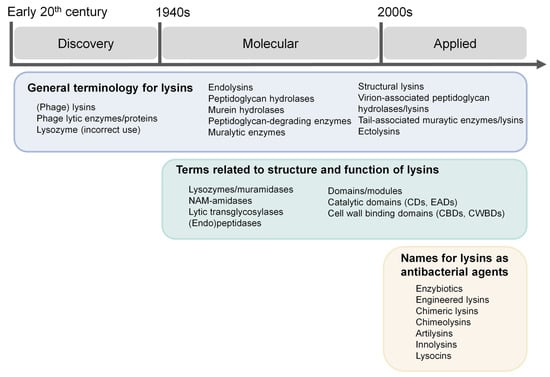
Figure 1
Open AccessArticle
Hesperidin Ameliorates Sarcopenia through the Regulation of Inflammaging and the AKT/mTOR/FoxO3a Signaling Pathway in 22–26-Month-Old Mice
Cells 2023, 12(15), 2015; https://doi.org/10.3390/cells12152015 - 07 Aug 2023
Abstract
Faced with a globally aging society, the maintenance of health and quality of life in older people is very important. The age-related loss of muscle mass and strength, known as sarcopenia, severely reduces quality of life and increases the risks of various diseases.
[...] Read more.
Faced with a globally aging society, the maintenance of health and quality of life in older people is very important. The age-related loss of muscle mass and strength, known as sarcopenia, severely reduces quality of life and increases the risks of various diseases. In this study, we investigated the inhibitory effect of hesperidin (HES) on inflammaging, with the intention of evaluating its potential use as a treatment for sarcopenia. We studied 22–26-month-old mice, corresponding to humans aged ≥70 years, with aging-related sarcopenia, and young mice aged 3–6 months. The daily administration of HES for 8 weeks resulted in greater muscle mass and strength and increased the fiber size of the old mice. HES also restored the immune homeostasis that had been disrupted by aging, such as the imbalance in M1/M2 macrophage ratio. In addition, we found that HES ameliorated the sarcopenia by regulating AKT/mammalian target of rapamycin/forkhead box 3a signaling through an increase in insulin-like growth factor (IGF)-1 expression in the old mice. Therefore, HES represents a promising candidate inhibitor of sarcopenia in older people, and its effects are achieved through the maintenance of immune homeostasis.
Full article
(This article belongs to the Collection Molecular Mechanisms to Target Cellular Senescence in Aging and Disease)
►▼
Show Figures
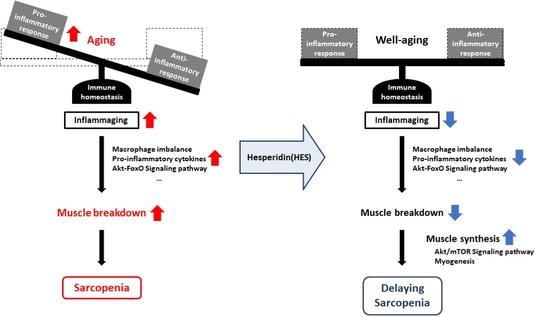
Graphical abstract
Open AccessCommunication
Implication of mTOR Signaling in NSCLC: Mechanisms and Therapeutic Perspectives
Cells 2023, 12(15), 2014; https://doi.org/10.3390/cells12152014 - 07 Aug 2023
Abstract
Mechanistic target of the rapamycin (mTOR) signaling pathway represents a central cellular kinase that controls cell survival and metabolism. Increased mTOR activation, along with upregulation of respective upstream and downstream signaling components, have been established as oncogenic features in cancer cells in various
[...] Read more.
Mechanistic target of the rapamycin (mTOR) signaling pathway represents a central cellular kinase that controls cell survival and metabolism. Increased mTOR activation, along with upregulation of respective upstream and downstream signaling components, have been established as oncogenic features in cancer cells in various tumor types. Nevertheless, mTOR pathway therapeutic targeting has been proven to be quite challenging in various clinical settings. Non-small cell lung cancer (NSCLC) is a frequent type of solid tumor in both genders, where aberrant regulation of the mTOR pathway contributes to the development of oncogenesis, apoptosis resistance, angiogenesis, cancer progression, and metastasis. In this context, the outcome of mTOR pathway targeting in clinical trials still demonstrates unsatisfactory results. Herewith, we discuss recent findings regarding the mechanisms and therapeutic targeting of mTOR signaling networks in NSCLC, as well as future perspectives for the efficient application of treatments against mTOR and related protein molecules.
Full article
(This article belongs to the Special Issue New Insights into Targeted Therapy for Non-Small-Cell Lung Cancer: From Molecular Biology to Tumor Microenvironment)
►▼
Show Figures
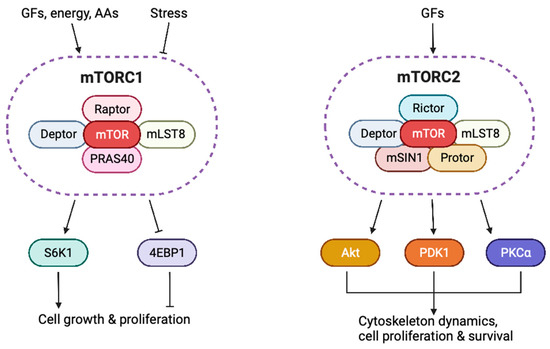
Figure 1
Open AccessReview
Current and Future Landscape in Genetic Therapies for Leber Hereditary Optic Neuropathy
Cells 2023, 12(15), 2013; https://doi.org/10.3390/cells12152013 - 07 Aug 2023
Abstract
Leber hereditary optic neuropathy (LHON) is the most common primary mitochondrial genetic disease that causes blindness in young adults. Over 50 inherited mitochondrial DNA (mtDNA) variations are associated with LHON; however, more than 95% of cases are caused by one of three missense
[...] Read more.
Leber hereditary optic neuropathy (LHON) is the most common primary mitochondrial genetic disease that causes blindness in young adults. Over 50 inherited mitochondrial DNA (mtDNA) variations are associated with LHON; however, more than 95% of cases are caused by one of three missense variations (m.11778 G > A, m.3460 G > A, and m.14484 T > C) encoding for subunits ND4, ND1, and ND6 of the respiration complex I, respectively. These variants remain silent until further and currently poorly understood genetic and environmental factors precipitate the visual loss. The clinical course that ensues is variable, and a convincing treatment for LHON has yet to emerge. In 2015, an antioxidant idebenone (Raxone) received European marketing authorisation to treat visual impairment in patients with LHON, and since then it was introduced into clinical practice in several European countries. Alternative therapeutic strategies, including gene therapy and gene editing, antioxidant and neurotrophic agents, mitochondrial biogenesis, mitochondrial replacement, and stem cell therapies are being investigated in how effective they might be in altering the course of the disease. Allotopic gene therapies are in the most advanced stage of development (phase III clinical trials) whilst most other agents are in phase I or II trials or at pre-clinical stages. This manuscript discusses the phenotype and genotype of the LHON disease with complexities and peculiarities such as incomplete penetrance and gender bias, which have challenged the therapies in development emphasising the most recent use of gene therapy. Furthermore, we review the latest results of the three clinical trials based on adeno-associated viral (AAV) vector-mediated delivery of NADH dehydrogenase subunit 4 (ND4) with mitochondrial targeting sequence, highlighting the differences in the vector design and the rationale behind their use in the allotopic transfer.
Full article
(This article belongs to the Special Issue Retinal Cell Biology in Health and Disease)
►▼
Show Figures
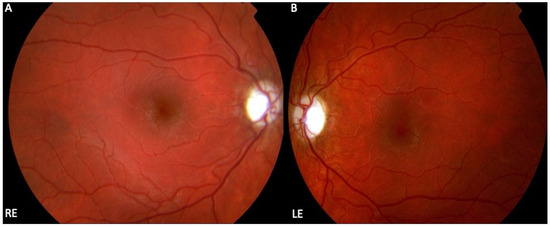
Figure 1
Open AccessReview
Biogenic Silver Nanoparticles for Targeted Cancer Therapy and Enhancing Photodynamic Therapy
Cells 2023, 12(15), 2012; https://doi.org/10.3390/cells12152012 - 07 Aug 2023
Abstract
Different conventional therapeutic procedures are utilized globally to manage cancer cases, yet the mortality rate in patients with cancer remains considerably high. Developments in the field of nanotechnology have included novel therapeutic strategies to deal with cancer. Biogenic (green) metallic silver nanoparticles (AgNPs)
[...] Read more.
Different conventional therapeutic procedures are utilized globally to manage cancer cases, yet the mortality rate in patients with cancer remains considerably high. Developments in the field of nanotechnology have included novel therapeutic strategies to deal with cancer. Biogenic (green) metallic silver nanoparticles (AgNPs) obtained using plant-mediated protocols are attractive to researchers exploring cancer treatment. Biogenic AgNPs present advantages, since they are cost-effective, easy to obtain, energy efficient, and less toxic compared to chemically and physically obtained AgNPs. Also, they present excellent anticancer abilities thanks to their unique sizes, shapes, and optical properties. This review provides recent advancements in exploring biogenic AgNPs as a drug or agent for cancer treatment. Thus, great attention was paid to the anticancer efficacy of biogenic AgNPs, their anticancer mechanisms, their efficacy in cancer photodynamic therapy (PDT), their efficacy in targeted cancer therapy, and their toxicity.
Full article
(This article belongs to the Special Issue Advances in the Interactions between Nanoparticles and Cells)
►▼
Show Figures
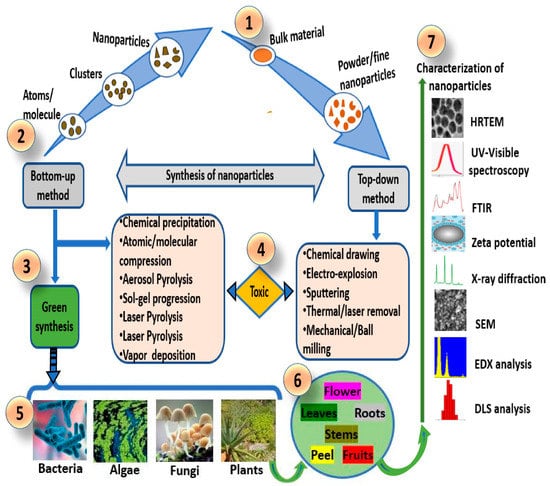
Figure 1
Open AccessArticle
Unveiling the Role of Cholesterol in Subnanomolar Ouabain Rescue of Cortical Neurons from Calcium Overload Caused by Excitotoxic Insults
by
, , , , , and
Cells 2023, 12(15), 2011; https://doi.org/10.3390/cells12152011 - 06 Aug 2023
Abstract
Na/K-ATPase maintains transmembrane ionic gradients and acts as a signal transducer when bound to endogenous cardiotonic steroids. At subnanomolar concentrations, ouabain induces neuroprotection against calcium overload and apoptosis of neurons during excitotoxic stress. Here, the role of lipid rafts in interactions between Na/K-ATPase,
[...] Read more.
Na/K-ATPase maintains transmembrane ionic gradients and acts as a signal transducer when bound to endogenous cardiotonic steroids. At subnanomolar concentrations, ouabain induces neuroprotection against calcium overload and apoptosis of neurons during excitotoxic stress. Here, the role of lipid rafts in interactions between Na/K-ATPase, sodium–calcium exchanger (NCX), and N-methy-D-aspartate receptors (NMDARs) was investigated. We analyzed 0.5–1-nanometer ouabain’s effects on calcium responses and miniature post-synaptic current (mEPSCs) frequencies of cortical neurons during the action of NMDA in rat primary culture and brain slices. In both objects, ouabain attenuated NMDA-evoked calcium responses and prevented an increase in mEPSC frequency, while the cholesterol extraction by methyl-β-cyclodextrin prevented the effects. The data support the conclusions that (i) ouabain-induced inhibition of NMDA-elicited calcium response involves both pre- and post-synapse, (ii) the presence of astrocytes in the tripartite synapse is not critical for the ouabain effects, which are found to be similar in cell cultures and brain slices, and (iii) ouabain action requires the integrity of cholesterol-rich membrane microdomains in which the colocalization and functional interaction of NMDAR-transferred calcium influx, calcium extrusion by NCX, and Na/K-ATPase modulation of the exchanger occur. This regulation of the molecules by cardiotonic steroids may influence synaptic transmission, prevent excitotoxic neuronal death, and interfere with the pharmacological actions of neurological medicines.
Full article
(This article belongs to the Special Issue Advances in Dissecting Calcium Signaling Pathways in Health and Diseases)
►▼
Show Figures
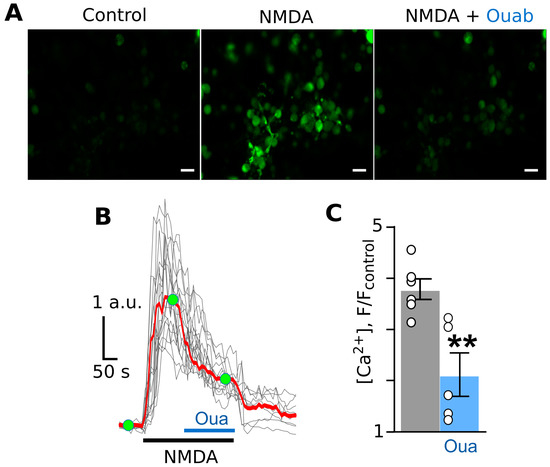
Figure 1
Open AccessArticle
GSK-J4 Inhibition of KDM6B Histone Demethylase Blocks Adhesion of Mantle Cell Lymphoma Cells to Stromal Cells by Modulating NF-κB Signaling
by
and
Cells 2023, 12(15), 2010; https://doi.org/10.3390/cells12152010 - 06 Aug 2023
Abstract
Multiple signaling pathways facilitate the survival and drug resistance of malignant B-cells by regulating their migration and adhesion to microenvironmental niches. NF-κB pathways are commonly dysregulated in mantle cell lymphoma (MCL), but the exact underlying mechanisms are not well understood. Here, using a
[...] Read more.
Multiple signaling pathways facilitate the survival and drug resistance of malignant B-cells by regulating their migration and adhesion to microenvironmental niches. NF-κB pathways are commonly dysregulated in mantle cell lymphoma (MCL), but the exact underlying mechanisms are not well understood. Here, using a co-culture model system, we show that the adhesion of MCL cells to stromal cells is associated with elevated levels of KDM6B histone demethylase mRNA in adherent cells. The inhibition of KDM6B activity, using either a selective inhibitor (GSK-J4) or siRNA-mediated knockdown, reduces MCL adhesion to stromal cells. We showed that KDM6B is required both for the removal of repressive chromatin marks (H3K27me3) at the promoter region of NF-κB encoding genes and for inducing the expression of NF-κB genes in adherent MCL cells. GSK-J4 reduced protein levels of the RELA NF-κB subunit and impaired its nuclear localization. We further demonstrated that some adhesion-induced target genes require both induced NF-κB and KDM6B activity for their induction (e.g., IL-10 cytokine gene), while others require induction of NF-κB but not KDM6B (e.g., CCR7 chemokine gene). In conclusion, KDM6B induces the NF-κB pathway at different levels in MCL, thereby facilitating MCL cell adhesion, survival, and drug resistance. KDM6B represents a novel potential therapeutic target for MCL.
Full article
(This article belongs to the Special Issue Cell Adhesion/Migration in Tumor Metastasis)
►▼
Show Figures
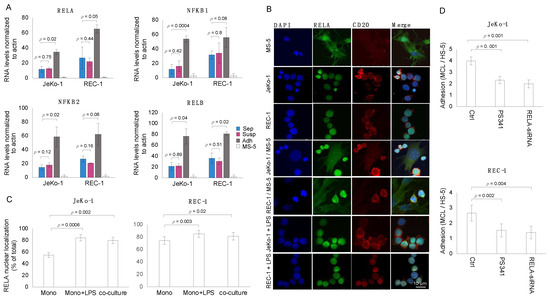
Figure 1
Open AccessArticle
Hepatocyte Sirtuin 6 Protects against Atherosclerosis and Steatohepatitis by Regulating Lipid Homeostasis
by
, , , , , , and
Cells 2023, 12(15), 2009; https://doi.org/10.3390/cells12152009 - 05 Aug 2023
Abstract
Histone deacetylase Sirtuin 6 (SIRT6) regulates many biological processes. SIRT6 is known to regulate hepatic lipid metabolism and inhibit the development of nonalcoholic fatty liver disease (NAFLD). We aimed to investigate the role of hepatocyte SIRT6 in the development of atherosclerosis and further
[...] Read more.
Histone deacetylase Sirtuin 6 (SIRT6) regulates many biological processes. SIRT6 is known to regulate hepatic lipid metabolism and inhibit the development of nonalcoholic fatty liver disease (NAFLD). We aimed to investigate the role of hepatocyte SIRT6 in the development of atherosclerosis and further characterize the mechanism underlying SIRT6’s effect on NAFLD. Ldlr−/− mice overexpressing or lacking hepatocyte SIRT6 were fed a Western diet for 16 weeks. The role of hepatic SIRT6 in the development of nonalcoholic steatohepatitis (NASH), atherosclerosis, and obesity was investigated. We also investigated whether p53 participates in the pathogenesis of NAFLD in mice overexpressing hepatic SIRT6. Our data show that loss of hepatocyte SIRT6 aggravated the development of NAFLD, atherosclerosis, and obesity in Ldlr−/− mice, whereas adeno-associated virus (AAV)-mediated overexpression of human SIRT6 in the liver had opposite effects. Mechanistically, hepatocyte SIRT6 likely inhibited the development of NAFLD by inhibiting lipogenesis, lipid droplet formation, and p53 signaling. Hepatocyte SIRT6 also likely inhibited the development of atherosclerosis by inhibiting intestinal lipid absorption and hepatic VLDL secretion. Hepatic SIRT6 also increased energy expenditure. In conclusion, our data indicate that hepatocyte SIRT6 protects against atherosclerosis, NAFLD, and obesity by regulating lipid metabolism in the liver and intestine.
Full article
(This article belongs to the Special Issue Lipid Metabolism and Metabolic Disorders)
►▼
Show Figures

Graphical abstract
Open AccessArticle
PAI-1 Regulation of p53 Expression and Senescence in Type II Alveolar Epithelial Cells
by
, , , , , and
Cells 2023, 12(15), 2008; https://doi.org/10.3390/cells12152008 - 05 Aug 2023
Abstract
Cellular senescence contributes importantly to aging and aging-related diseases, including idiopathic pulmonary fibrosis (IPF). Alveolar epithelial type II (ATII) cells are progenitors of alveolar epithelium, and ATII cell senescence is evident in IPF. Previous studies from this lab have shown that increased expression
[...] Read more.
Cellular senescence contributes importantly to aging and aging-related diseases, including idiopathic pulmonary fibrosis (IPF). Alveolar epithelial type II (ATII) cells are progenitors of alveolar epithelium, and ATII cell senescence is evident in IPF. Previous studies from this lab have shown that increased expression of plasminogen activator inhibitor 1 (PAI-1), a serine protease inhibitor, promotes ATII cell senescence through inducing p53, a master cell cycle repressor, and activating p53-p21-pRb cell cycle repression pathway. In this study, we further show that PAI-1 binds to proteasome components and inhibits proteasome activity and p53 degradation in human lung epithelial A549 cells and primary mouse ATII cells. This is associated with a senescence phenotype of these cells, manifested as increased p53 and p21 expression, decreased phosphorylated retinoblastoma protein (pRb), and increased senescence-associated beta-galactose (SA-β-gal) activity. Moreover, we find that, although overexpression of wild-type PAI-1 (wtPAI-1) or a secretion-deficient, mature form of PAI-1 (sdPAI-1) alone induces ATII cell senescence (increases SA-β-gal activity), only wtPAI-1 induces p53, suggesting that the premature form of PAI-1 is required for the interaction with the proteasome. In summary, our data indicate that PAI-1 can bind to proteasome components and thus inhibit proteasome activity and p53 degradation in ATII cells. As p53 is a master cell cycle repressor and PAI-1 expression is increased in many senescent cells, the results from this study will have a significant impact not only on ATII cell senescence/lung fibrosis but also on the senescence of other types of cells in different diseases.
Full article
(This article belongs to the Topic Molecular and Cellular Mechanisms of Chronic Respiratory and Allergic Diseases)
►▼
Show Figures
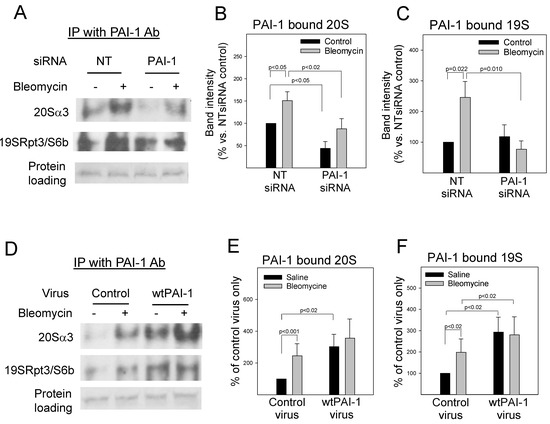
Figure 1

Journal Menu
► ▼ Journal Menu-
- Cells Home
- Aims & Scope
- Editorial Board
- Reviewer Board
- Topical Advisory Panel
- Instructions for Authors
- Special Issues
- Topics
- Sections & Collections
- Article Processing Charge
- Indexing & Archiving
- Editor’s Choice Articles
- Most Cited & Viewed
- Journal Statistics
- Journal History
- Journal Awards
- Society Collaborations
- Conferences
- Editorial Office
Journal Browser
► ▼ Journal BrowserHighly Accessed Articles
Latest Books
E-Mail Alert
News
Topics
Topic in
BioChem, Cancers, Cells, IJMS, IJERPH, Biomolecules, Environments, Toxics
Environmental Toxicology and Human Health
Topic Editors: Esref Demir, Sam KacewDeadline: 31 August 2023
Topic in
Biomolecules, Cells, CIMB, IJMS, JMP, Molecules, Proteomes
Metalloproteins and Metalloenzymes
Topic Editors: Eugene A. Permyakov, Ludmilla Morozova-RocheDeadline: 30 September 2023
Topic in
Cells, Epigenomes, Genes, IJMS, IJTM
Stem Cell Differentiation and Applications
Topic Editors: Hiroyuki Hirai, Haiyun Pei, Atsushi AsakuraDeadline: 20 October 2023
Topic in
Cancers, Cells, Diagnostics, Future Pharmacology, Pharmaceutics
New Molecular Targets and Novel Strategies in Drug Development to Prevent Relapse in Acute Leukemia
Topic Editors: Oxana Dobrovinskaya, Ivan Delgado-EncisoDeadline: 31 October 2023

Conferences
Special Issues
Special Issue in
Cells
Crosstalk between the Bone Marrow Microenvironment and Breast Cancer
Guest Editor: Pranela RameshwarDeadline: 10 August 2023
Special Issue in
Cells
Inhibiting Immune Checkpoint-Expressing Cells for Tumor Therapy
Guest Editor: Fabrizio MarcucciDeadline: 15 August 2023
Special Issue in
Cells
Cell and Molecular Causes of Joint Inflammation and Damage
Guest Editor: Gundula Schulze-TanzilDeadline: 31 August 2023
Special Issue in
Cells
Intervertebral Disc Degeneration and Its Regeneration
Guest Editor: Hideki SudoDeadline: 10 September 2023
Topical Collections
Topical Collection in
Cells
Role of Autophagy in Viral Infection
Collection Editor: Grant R. Campbell
Topical Collection in
Cells
Tumor Metabolism and Therapy
Collection Editors: Guohui Sun, Jianhua Wang
Topical Collection in
Cells
Molecular signaling, Circuit Neuroplasticity and the Cognitive Function
Collection Editor: Francisco Monje





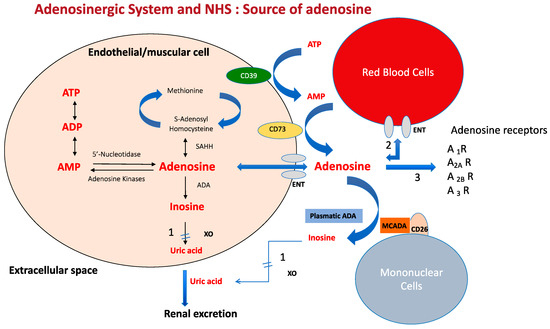









.jpg)




